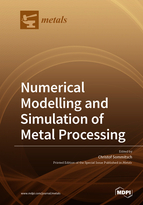Numerical Modelling and Simulation of Metal Processing
A special issue of Metals (ISSN 2075-4701).
Deadline for manuscript submissions: closed (30 December 2020) | Viewed by 76507
Special Issue Editor
Interests: materials development in steels and aluminum alloys; welding; metal forming; modelling and simulation of metal processing; additive manufacturing
Special Issues, Collections and Topics in MDPI journals
Special Issue Information
Dear Colleagues,
The service properties of materials strongly depend on the chemical composition, as well as their processing conditions. The specific applications and the optimization of thermal and thermo-mechanical processes, respectively, enable both, to save processes and to treat new alloy variants, as well as to realize materials with special properties. The numerical simulation of metal processing, coupled with the modelling of the structural evolution allows to reduce time and cost expensive tests at lab and industrial scale. Here, multi-scale modelling is an appropriate means to describe the development of the nano, micro and macro structure and, hence, to determine the local materials properties.
Prof. Christof Sommitsch
Guest Editor
Manuscript Submission Information
Manuscripts should be submitted online at www.mdpi.com by registering and logging in to this website. Once you are registered, click here to go to the submission form. Manuscripts can be submitted until the deadline. All submissions that pass pre-check are peer-reviewed. Accepted papers will be published continuously in the journal (as soon as accepted) and will be listed together on the special issue website. Research articles, review articles as well as short communications are invited. For planned papers, a title and short abstract (about 100 words) can be sent to the Editorial Office for announcement on this website.
Submitted manuscripts should not have been published previously, nor be under consideration for publication elsewhere (except conference proceedings papers). All manuscripts are thoroughly refereed through a single-blind peer-review process. A guide for authors and other relevant information for submission of manuscripts is available on the Instructions for Authors page. Metals is an international peer-reviewed open access monthly journal published by MDPI.
Please visit the Instructions for Authors page before submitting a manuscript. The Article Processing Charge (APC) for publication in this open access journal is 2600 CHF (Swiss Francs). Submitted papers should be well formatted and use good English. Authors may use MDPI's English editing service prior to publication or during author revisions.
Keywords
- Materials Modelling
- Process Simulation
- Metal Forming
- Welding
- Joining
- Additive Manufacturing






